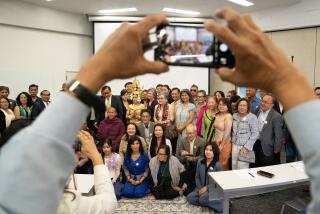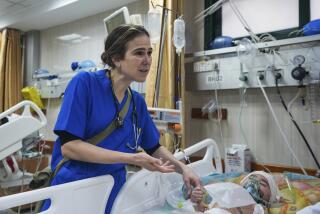Nature Takes Toll on Cambodia’s Ill, Hungry Children
PHNOM PENH, Cambodia — Ten years after the war in Cambodia, nature shows no mercy; there is no break in the seasons of death.
Fall, winter, spring and summer all bring a new onslaught of disease or hunger.
Hospitals and orphanages are overflowing with children who officials say are malnourished.
The fall and winter bring an increase in respiratory diseases including pneumonia and bronchitis.
In spring, diarrhea, dehydration and typhoid are rampant from water contamination caused by a limited supply due to the hotter weather.
Measles, a killer disease in Cambodia with a high mortality rate for children between the ages of 6 months and 3 years, is prevalent between winter and spring because of the lack of a common 30-cent shot of vaccine.
Summer’s rainy season breeds mosquitoes that inflict malaria, dengue and hemorrhagic fever.
Because an estimated 80% of Cambodia’s children are malnourished, they are more susceptible to the ravages of diseases, lacking the proteins that make up antibodies to fight off the infections, according to Dr. Douglas R. Mendoza, an international aid official from the Philippines.
The death rate is staggering.
According to U.N. officials, 15 out of 100 Cambodian infants die in their first year of life in contrast with 1.1 in the United States.
“This is the lowest estimate,” says one official. “It could be more.”
Children under 15 make up 48% of Cambodia’s population, estimated to be anywhere from 7.2 million, the official Phnom Penh government figure, to between 6 million and 6.5 million, the figure put forth by Western diplomats.
Mendoza says the recovery rate at the National Pediatric Hospital has improved slightly in the past two years.
“Our recovery rate at this time is something like 50% to 60%,” he says. “So that means we are losing less patients to malnutrition in contrast to say two years back when our mortality rate was about 60% and our recovery rate was 40%.”
World Vision, an international Christian humanitarian organization with world headquarters in Monrovia, Calif., built the National Pediatric Hospital in 1975. But it was taken over by the Communist Khmer Rouge forces of Pol Pot when they captured Phnom Penh from the U.S.-backed government of Lon Nol 10 years ago.
During the nearly four years Pol Pot was in power, the Khmer Rouge destroyed much of Phnom Penh in a campaign to wipe out the remnants of the old society.
Hospitals were emptied and patients were among the hundreds of thousands forced into the countryside. Estimates of the number of people who were killed by the Khmer Rouge or who died of starvation and disease under their rule range from 1.5 million to 3 million.
Vietnamese troops invaded Cambodia on Christmas Day, 1978, and ousted Pol Pot. Heng Samrin, a former Khmer Rouge official whom the Vietnamese felt they could control, was installed as head of state.
Mendoza, project director for World Vision, says the pediatric hospital was designed primarily to restore child health care services in Cambodia.
“Infectious diseases that could be prevented like tetanus, croup, tuberculosis and measles are common,” Mendoza says. “There is already a tremendous effort in vaccinating our kids.
“But, of course, there is still a need to expand to the provinces and there is a need to educate the mothers to enroll their kids in the under-five clinics so that their health is followed up from year zero to year five.”
The hospital is so overcrowded that it has more than 120 patients and only 75 beds. Children are laid out on mats in the corridors, their anxious parents squatting at their side.
One ward is for abandoned children. They are under a year old, their eyes bulging with fear. Tubes, chest drains and intravenous equipment extend from their noses, chests and scalps. Oxygen tanks tower over them. Some have as many as 10 to 20 problems.
--Ratana, a 3-month-old boy, is suffering from bronchial pneumonia, diarrhea and malnutrition. He is crying and it is no wonder. A machine called a syringe infusion pump is pushing milk formula into his stomach through a nasal-gastric tube clamped into his nose. A butterfly needle has been inserted into his scalp for intravenous feeding.
--Srey Mon, 6 months old, was admitted with diarrhea, dehydration, malnutrition and anemia. Her blood flow was reduced, perhaps from complications from transfusions she received. Two fingers on her right hand had to be amputated.
--Wendy Lock, an Australian doctor at the hospital, is working over Phary, a 2-year-old girl suffering from measles. During her illness, her left cornea was perforated due to a deficiency in vitamin A that she would get if her diet included fruits and vegetables. She will lose the sight in her left eye.
--Nine-month-old Keo Meas is severely malnourished. She has diarrhea, pulmonary tuberculosis and a collapsed left lung. A tube has been placed into her tiny chest to drain the puss from the collapsed lung. An intravenous tube has been inserted into her scalp.
--Sorya, the 5 1/2-month-old son of a government official, is not expected to live long. He is having severe difficulty breathing because of bronchitis, acidosis, virus and high fever. He is dehydrated. There is no strength in his body. His feet and arms are flaccid, like rubber, his skin wrinkled. He is semicomatose, being fed milk through a nasal-gastric tube.
Weighs Just 6 Pounds
He also has many congenital defects. He is mentally and physically handicapped. He weighs only six pounds, less than the average for a newborn Asian child. But just the same, he is gasping for breath, refusing to give up. Even though there is no full-fledged doctor for the emergency room, the staff sees up to 700 out-patients a day.
Western doctors at the hospital say the out-patient system is not a good one because there are too many patients and too little staff. They say at best the system filters out the seriously ill and provides token care for the others.
The hospital is so poor that it has to recycle surgical gloves, needles and syringes.
Western Bloc nations do not recognize the Phnom Penh government because it is Vietnamese-installed. For this reason they have cut Cambodia off from most aid. Some countries provide humanitarian aid.
More to Read
Sign up for Essential California
The most important California stories and recommendations in your inbox every morning.
You may occasionally receive promotional content from the Los Angeles Times.










